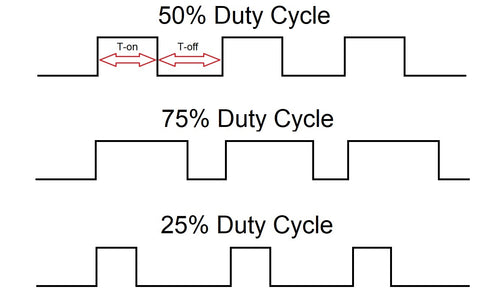Understanding Duty Cycle in a linear actuator?
The Duty Cycle of an intermittent machine is defined as the ratio of running vs resting time, expressed as a percentage. Put simply, The Duty cycle is the ratio of Time 'On' to Time 'Off'.
For example: A Linear Actuator with a 75% duty cycle would operate for 45 seconds, and then require rest for 15 seconds. The example unit then spends 25% of its time 'resting', and 75% operating. (These are example numbers only.)
Duty cycles are typically 10-75% and mostly depend on load.
How is Duty Cycle in a Linear Actuator Calculated?
Below is the equation for calculating duty cycle. Duty cycle is a binary operation (off or on, with no in-between state), thus the Y axis is unlabeled. The X-axis is time, but we are dealing with a ratio, so again, actual units do not matter.
Using the example above for this formula: T-On = 45, T-Off = 15
(45/(45+15)) or 45/60 = 0.75


Is duty cycle important in a Linear Actuator?
It depends. Most consumer applications will not need to worry about the Duty Cycle. Firgelli actuator duty cycles use an assumed 5 minutes of continuous use. In this context, a 25% duty cycle (25% on, 75% off) consists of 5 minutes on, then 15 minutes off before using again. In other words, if you're moving your actuator for less than 5 minutes straight, you probably won't need to worry about duty cycle (but you'll want to keep it in mind while you're showing off to family and friends!)
The lifespan of a Linear Actuator can be affected by several factors; Duty Cycle, Power Usage, and even the environment. One way to think about it: if you drive a car at max speed, constantly, it is not likely to last as long as a car that is driven at lower speeds and allowed to rest and cool. Switching back to Actuators; the standard failure state of a Linear Actuator is when the motor brushes lose connection with the motor spindle. At that point, the motor does not work at all - this will eventually happen to all DC brushed motors, but maintaining the unit within specification will give you the longest product life. Duty Cycles are intended to prevent overheating. Linear Actuators will fail quickly if they overheat.
There are several instances that will cause an actuator to run the risk of overheating; The first is to run the Actuator at (or near) its maximum force capacity. Running an actuator near its limits will raise the power draw from the motor; when this happens, the motor components begin to heat up steadily during use. This is when Duty Cycle matters; the actuator motor needs to cool off before being re-energized. Not allowing the unit to cool will cause the conductive elements heat and lose conductivity, killing the motor.
Second, running an actuator continuously under load will have a similar effect, compounded by the weight of the load. Higher load and a longer 'on' time results in a faster burn-out failure.
The last actuator-dooming use is dead-driving into an object. Dead Driving is when the actuator is physically pushing into an obstruction that will not or cannot move. The actuator motor will do it's absolute best, but will burn out relatively quickly. Without any motion out of the unit, this scenario causes electrical current to pass through the motor without doing work, meaning that all the power is dissipated as heat through the motor components. This will cause your actuator to burn out very quickly if unnoticed.
To prevent this last instance, we recommend the FA-POCT Overcurrent Protection Unit. Click here to learn more about this component [Video].
It is possible to run a Linear Actuator at 100% duty cycle if the load is considerably lower than the actuator's maximum capacity and the actuator is in a non-hostile environment.
In short: the farther you are from the actuator's specified service limits, the longer the unit will last. You can press the limits of some particular specifications by keeping your system well within every other specification's functional range.
How to Lower Duty Cycle in a Linear Actuator
Lowering the duty cycle is simple, but not always necessary. If you are using a Linear Actuator on an application that requires a low force or is in a colder environment, you may not need to lower the duty cycle. If you are concerned that that environment is going to be too hot or that the force you need is too high then you may need to consider getting an Actuator with a higher force rating to keep your application further into the unit's load range. So if you need 50lbs of force, consider buying a 100-200lbs force Linear Actuator. Remember you can limit applied force with a FA-POCT, mentioned earlier.
Another option is to allow ventilation into your device such that the Actuators can cool down to keep a lower temperature. At a lower temperature, the brushes inside the motors will survive much longer.
How do you control Duty Cycle in an Actuator
The best way to control the Duty cycle is to connect the Linear Actuator to some sort of a micro-controller. These controllers allow you to program exactly how long and when you want your Actuator to operate. Arduino's are the most common type of controller and they are very easy to program and use. Feel free to reach out to our Tech Department* to get help with this, or view our Tutorials in the Resources tab of this website. To view all our microcontrollers and Arduino options, click here.
*Tech Note: We do not have the resources to develop PLC code for you; we do have links, tutorials, videos, and other relevant reference info to help you develop your own. You also have the option of hiring a freelance Arduino programmer for your project.